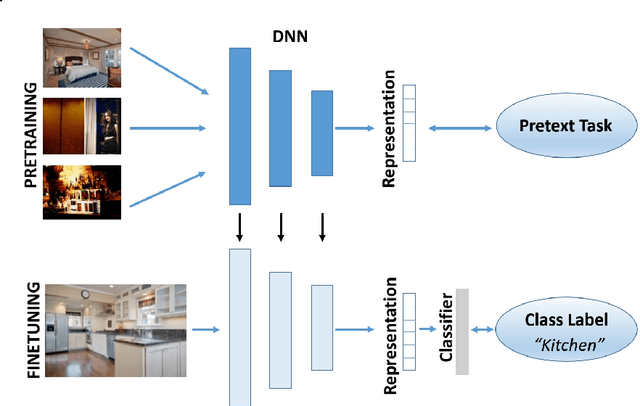Sotirios Konstantakos
Self-supervised visual learning in the low-data regime: a comparative evaluation
Apr 26, 2024



Abstract:Self-Supervised Learning (SSL) is a valuable and robust training methodology for contemporary Deep Neural Networks (DNNs), enabling unsupervised pretraining on a `pretext task' that does not require ground-truth labels/annotation. This allows efficient representation learning from massive amounts of unlabeled training data, which in turn leads to increased accuracy in a `downstream task' by exploiting supervised transfer learning. Despite the relatively straightforward conceptualization and applicability of SSL, it is not always feasible to collect and/or to utilize very large pretraining datasets, especially when it comes to real-world application settings. In particular, in cases of specialized and domain-specific application scenarios, it may not be achievable or practical to assemble a relevant image pretraining dataset in the order of millions of instances or it could be computationally infeasible to pretrain at this scale. This motivates an investigation on the effectiveness of common SSL pretext tasks, when the pretraining dataset is of relatively limited/constrained size. In this context, this work introduces a taxonomy of modern visual SSL methods, accompanied by detailed explanations and insights regarding the main categories of approaches, and, subsequently, conducts a thorough comparative experimental evaluation in the low-data regime, targeting to identify: a) what is learnt via low-data SSL pretraining, and b) how do different SSL categories behave in such training scenarios. Interestingly, for domain-specific downstream tasks, in-domain low-data SSL pretraining outperforms the common approach of large-scale pretraining on general datasets. Grounded on the obtained results, valuable insights are highlighted regarding the performance of each category of SSL methods, which in turn suggest straightforward future research directions in the field.
Self-supervised visual learning for analyzing firearms trafficking activities on the Web
Oct 12, 2023Abstract:Automated visual firearms classification from RGB images is an important real-world task with applications in public space security, intelligence gathering and law enforcement investigations. When applied to images massively crawled from the World Wide Web (including social media and dark Web sites), it can serve as an important component of systems that attempt to identify criminal firearms trafficking networks, by analyzing Big Data from open-source intelligence. Deep Neural Networks (DNN) are the state-of-the-art methodology for achieving this, with Convolutional Neural Networks (CNN) being typically employed. The common transfer learning approach consists of pretraining on a large-scale, generic annotated dataset for whole-image classification, such as ImageNet-1k, and then finetuning the DNN on a smaller, annotated, task-specific, downstream dataset for visual firearms classification. Neither Visual Transformer (ViT) neural architectures nor Self-Supervised Learning (SSL) approaches have been so far evaluated on this critical task. SSL essentially consists of replacing the traditional supervised pretraining objective with an unsupervised pretext task that does not require ground-truth labels..
 Add to Chrome
Add to Chrome Add to Firefox
Add to Firefox Add to Edge
Add to Edge